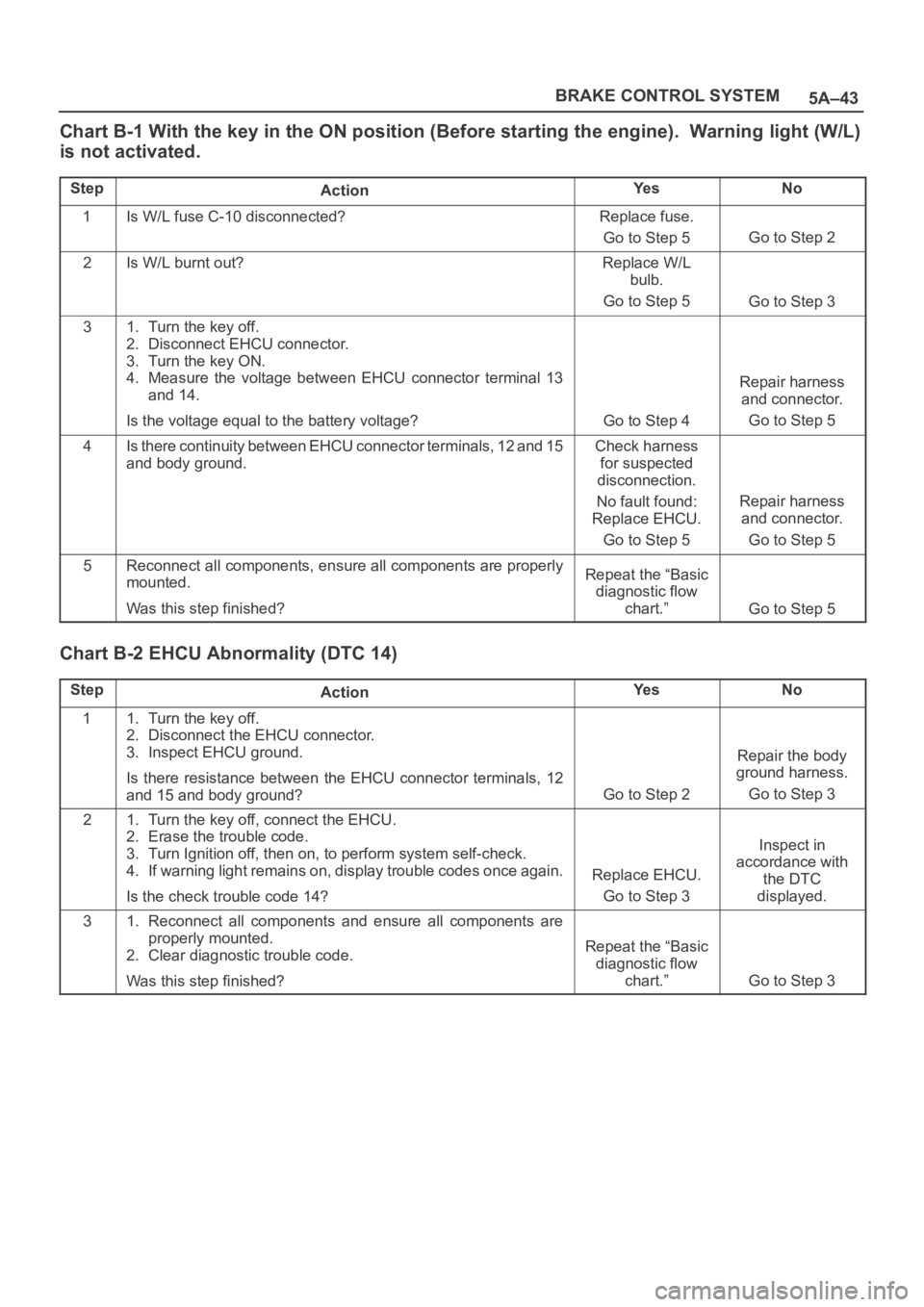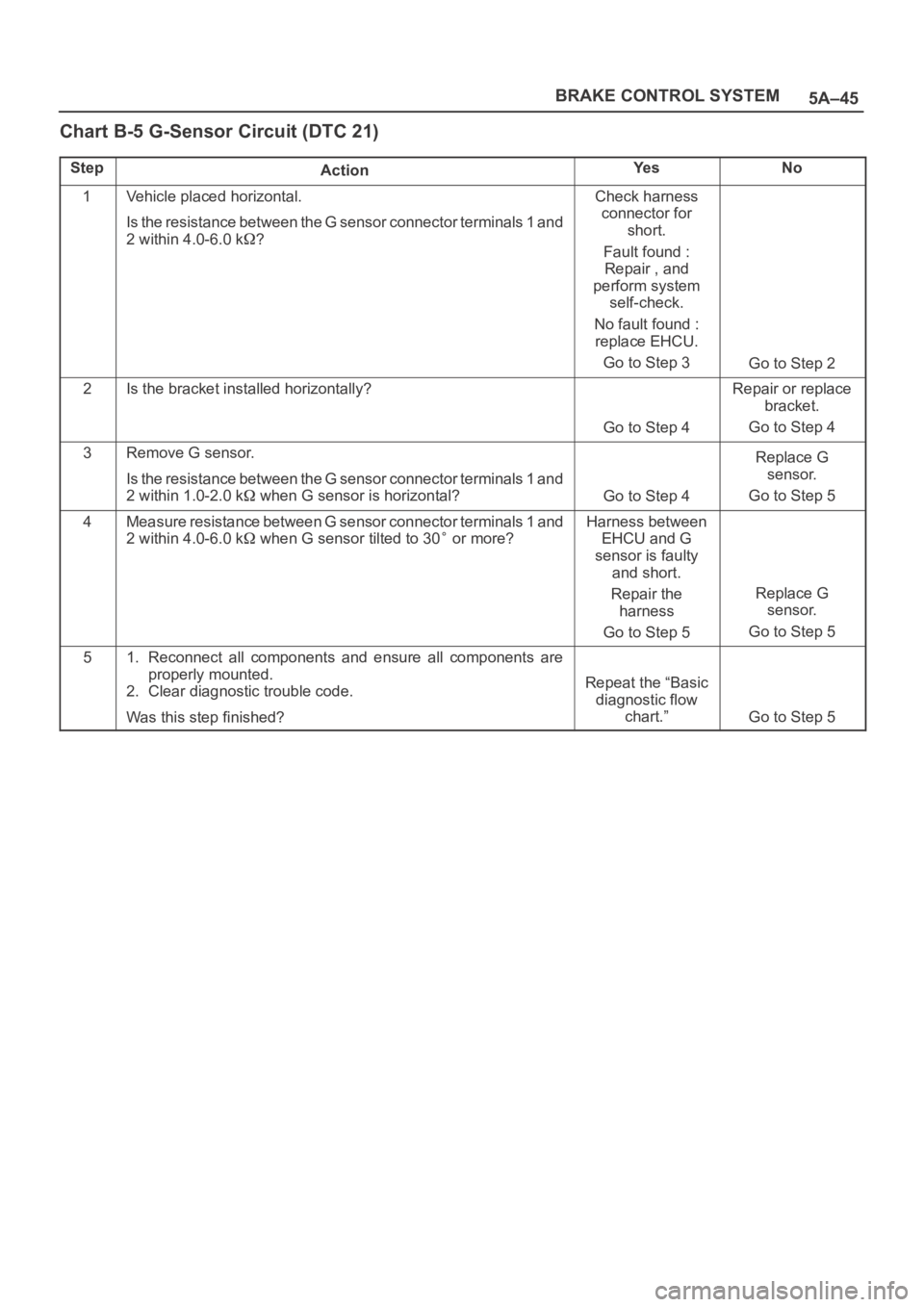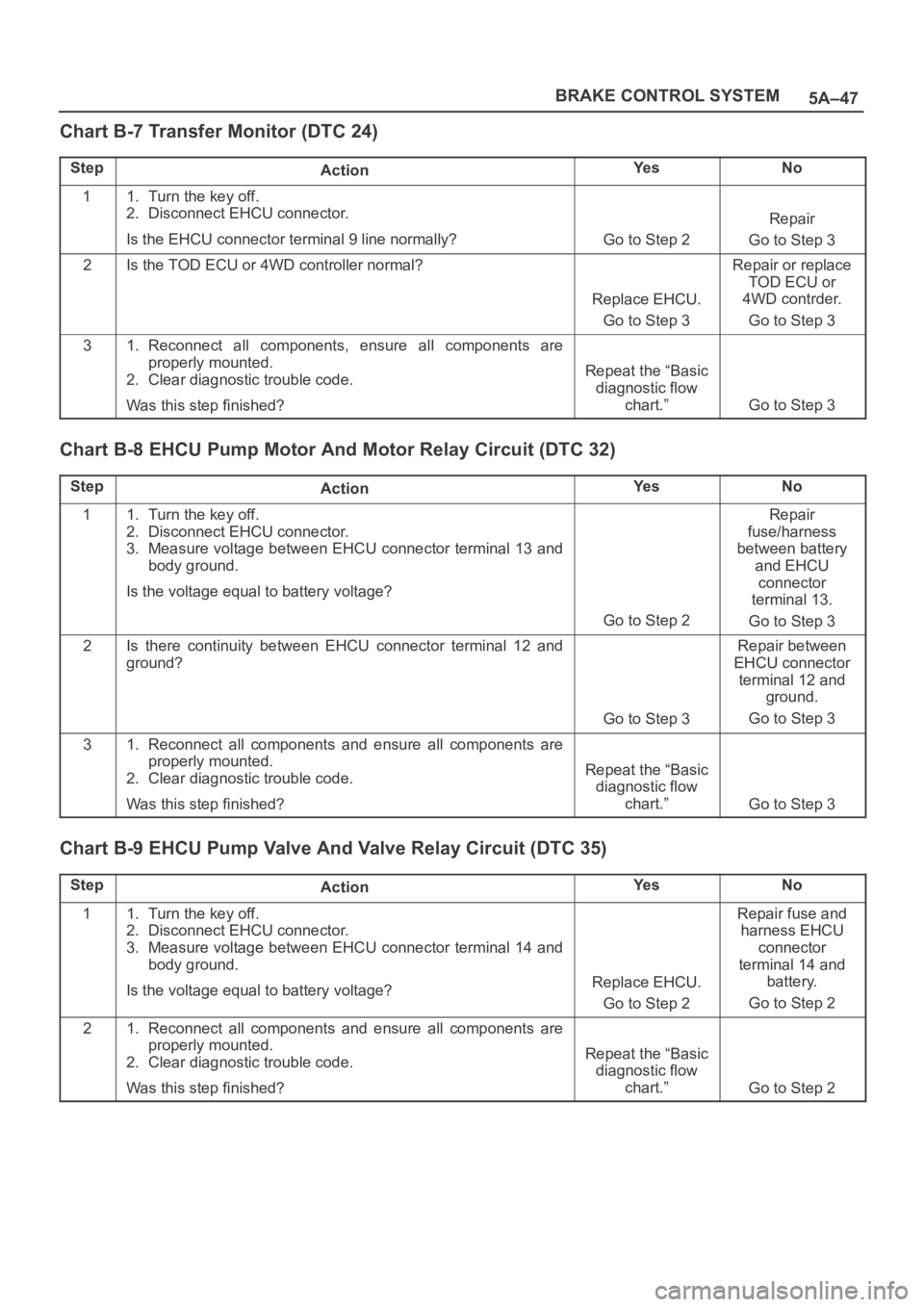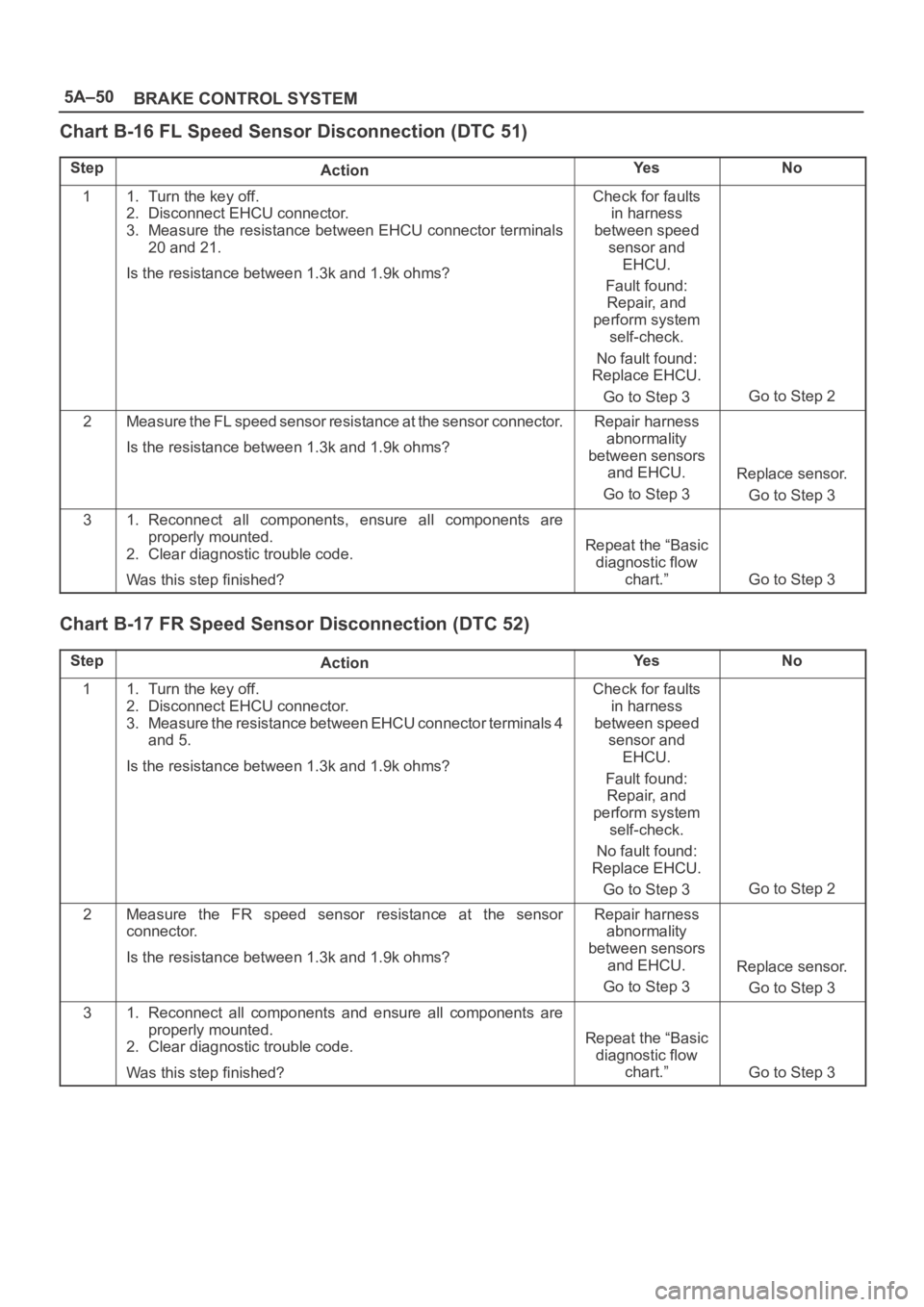OPEL FRONTERA 1998 Workshop Manual
Manufacturer: OPEL, Model Year: 1998, Model line: FRONTERA, Model: OPEL FRONTERA 1998Pages: 6000, PDF Size: 97 MB
Page 851 of 6000

5A–41 BRAKE CONTROL SYSTEM
The DLC is located behind the center console
350RV010
Keep #12 terminal connected with #4 terminal or # 5
terminal (GND) during DTC display. (If #12 terminal
is separated from #4 terminal or # 5 terminal (GND)
during display, display will stop.)
2. DTC display:
DTC is displayed by blinking warning light.
Double-digit display.
First, normal DTC 12 is displayed three times and
then any other DTCs are displayed three times. (If
no other DTCs have been stored, the display of DTC
12 will be repeated.)
3. How to erase code:
Conduct brake switch ON/OFF operation 6 or more
times within 3 seconds of self-diagnosis startup.
The code cannot be erased if more than 3 seconds
have passed since self-diagnosis startup, or if
self-diagnosis has started with brake switched on
(brake pedal depressed).
B05RW005
Page 852 of 6000

5A–42
BRAKE CONTROL SYSTEM
4. Notes
If the following should occurs during Diagnostic
Trouble Code (DTC) display the display will be
discontinued. After initial check, the status that is
under the control of ABS will be returned :
– The vehicle starts (The wheels turn) or the brake
pedal is depressed.
Up to 3 different codes can be stored.
If the ABS should turn OFF due to an intermittent
defect, the system will be restored at the next key
cycle, if the initial check finds no abnormality (when
IGN is switched from OFF to ON).
5. An example of DTC display
Display of DTC 23
B05RW006
After displaying DTC 12 three times, one DTC after
another is displayed, starting with the most recent
one. (However, display is discontinued after about 5
minutes.)
B05RS005
The DTC 12 is displayed repeatedly. (display is
discontinued after about 5 minutes)
Page 853 of 6000

5A–43 BRAKE CONTROL SYSTEM
Chart B-1 With the key in the ON position (Before starting the engine). Warning light (W/L)
is not activated.
StepActionYe sNo
1Is W/L fuse C-10 disconnected?Replace fuse.
Go to Step 5
Go to Step 2
2Is W/L burnt out?Replace W/L
bulb.
Go to Step 5
Go to Step 3
31. Turn the key off.
2. Disconnect EHCU connector.
3. Turn the key ON.
4. Measure the voltage between EHCU connector terminal 13
and 14.
Is the voltage equal to the battery voltage?
Go to Step 4
Repair harness
and connector.
Go to Step 5
4Is there continuity between EHCU connector terminals, 12 and 15
and body ground.Check harness
for suspected
disconnection.
No fault found:
Replace EHCU.
Go to Step 5
Repair harness
and connector.
Go to Step 5
5Reconnect all components, ensure all components are properly
mounted.
Was this step finished?Repeat the “Basic
diagnostic flow
chart.”
Go to Step 5
Chart B-2 EHCU Abnormality (DTC 14)
StepActionYe sNo
11. Turn the key off.
2. Disconnect the EHCU connector.
3. Inspect EHCU ground.
Is there resistance between the EHCU connector terminals, 12
and 15 and body ground?
Go to Step 2
Repair the body
ground harness.
Go to Step 3
21. Turn the key off, connect the EHCU.
2. Erase the trouble code.
3. Turn Ignition off, then on, to perform system self-check.
4. If warning light remains on, display trouble codes once again.
Is the check trouble code 14?
Replace EHCU.
Go to Step 3
Inspect in
accordance with
the DTC
displayed.
31. Reconnect all components and ensure all components are
properly mounted.
2. Clear diagnostic trouble code.
Was this step finished?
Repeat the “Basic
diagnostic flow
chart.”
Go to Step 3
Page 854 of 6000

5A–44
BRAKE CONTROL SYSTEM
Chart B-3 Power Voltage Drop (DTC 15)
StepActionYe sNo
1Is the battery voltage normal? (Battery capacity check)
Go to Step 2
Charge or
replace battery.
Go to Step 2
21. Turn the key off.
2. Disconnect EHCU connector.
3. Turn the key on.
Is the voltage between EHCU connector terminals 8 and 15,
higher than 10V?Check harness
connector for
suspected
disconnection.
Fault found:
Repair, and
perform system
self-check.
No fault found:
replace EHCU.
Go to Step 3
Repair harness or
connector.
Go to Step 3
31. Reconnect all components, ensure all components are
properly mounted.
2. Clear diagnostic trouble code.
Was this step finished?
Repeat the “Basic
diagnostic flow
chart.”
Go to Step 3
Chart B-4 CLASS-2 Communication Line Abnormality (DTC 16)
StepActionYe sNo
11. Turn the key off.
2. Disconnect EHCU and PCM connector.
Is there continuity between EHCU connector terminals 25 and
ground?
Go to Step 2
Repair harness or
connector.
Go to Step 3
21. Connect EHCU connector.
2. Clear diagnostic trouble code.
3. Turn the key on.
Is the diagnostic trouble code 16 shown on the displayed?Check the PCM
harness. Refer to
6E section.
Go to Step 3
Replace EHCU.
Go to Step 3
31. Reconnect all components, ensure all components are
properly mounted.
2. Clear diagnostic trouble code.
Was this step finished?
Repeat the “Basic
diagnostic flow
chart.”
Go to Step 3
Page 855 of 6000

5A–45 BRAKE CONTROL SYSTEM
Chart B-5 G-Sensor Circuit (DTC 21)
StepActionYe sNo
1Vehicle placed horizontal.
Is the resistance between the G sensor connector terminals 1 and
2 within 4.0-6.0 k
?
Check harness
connector for
short.
Fault found :
Repair , and
perform system
self-check.
No fault found :
replace EHCU.
Go to Step 3
Go to Step 2
2Is the bracket installed horizontally?
Go to Step 4
Repair or replace
bracket.
Go to Step 4
3Remove G sensor.
Is the resistance between the G sensor connector terminals 1 and
2 within 1.0-2.0 k
when G sensor is horizontal?Go to Step 4
Replace G
sensor.
Go to Step 5
4Measure resistance between G sensor connector terminals 1 and
2 within 4.0-6.0 k
when G sensor tilted to 30 or more?
Harness between
EHCU and G
sensor is faulty
and short.
Repair the
harness
Go to Step 5
Replace G
sensor.
Go to Step 5
51. Reconnect all components and ensure all components are
properly mounted.
2. Clear diagnostic trouble code.
Was this step finished?
Repeat the “Basic
diagnostic flow
chart.”
Go to Step 5
Page 856 of 6000

5A–46
BRAKE CONTROL SYSTEM
Chart B-6 Abnormal Transmission Input (DTC 23)
StepActionYe sNo
11. Turn the key off.
2. Disconnect EHCU connector.
Is there continuity between EHCU connector terminal 6 to 15
(Gear position-P(A/T), N(M/T))?Shorted switch
harness.
Repair switch or
harness.
Go to Step 6
Go to Step 2
2Is the vehicle an A/T model?Go to Step 3Go to Step 4
3Turn the key on and measure the voltage between EHCU
connector terminal 6 and 15.
Is the 6V under when the gear position is L, and R(Battery voltage
12V)?
Go to Step 5
Transmission SW
trouble.
Disconnected
harness.
Repair SW and
harness.
Go to Step 6
4Turn the key on and measure the voltage between EHCU
connector terminal 6 and 15.
Is the 9.6V over when the gear position is 1, 2, R(Battery voltage
12V)?
Go to Step 5
Transmission SW
trouble.
Disconnected
harness.
Repair SW and
harness.
Go to Step 6
5Is there 6.6 to 9.0V when the gear position is 3, 4, 5 and N(M/T) or
2,3,D,N and P(A/T)(Battery voltage 12V)?Suspected
harness/
connector short
power
source/GND.
Suspected
shorted
transmission SW.
Fault found:
repair, and
perform system
self-check.
No fault found:
replace EHCU.
Go to Step 6
Transmission SW
trouble.
Disconnected
harness.
Repair SW and
harness.
Go to Step 6
61. Reconnect all components, ensure all components are
properly mounted.
2. Clear diagnostic trouble code.
Was this step finished?
Repeat the “Basic
diagnostic flow
chart.”
Go to Step 6
Page 857 of 6000

5A–47 BRAKE CONTROL SYSTEM
Chart B-7 Transfer Monitor (DTC 24)
StepActionYe sNo
11. Turn the key off.
2. Disconnect EHCU connector.
Is the EHCU connector terminal 9 line normally?
Go to Step 2
Repair
Go to Step 3
2Is the TOD ECU or 4WD controller normal?
Replace EHCU.
Go to Step 3
Repair or replace
TOD ECU or
4WD contrder.
Go to Step 3
31. Reconnect all components, ensure all components are
properly mounted.
2. Clear diagnostic trouble code.
Was this step finished?
Repeat the “Basic
diagnostic flow
chart.”
Go to Step 3
Chart B-8 EHCU Pump Motor And Motor Relay Circuit (DTC 32)
StepActionYe sNo
11. Turn the key off.
2. Disconnect EHCU connector.
3. Measure voltage between EHCU connector terminal 13 and
body ground.
Is the voltage equal to battery voltage?
Go to Step 2
Repair
fuse/harness
between battery
and EHCU
connector
terminal 13.
Go to Step 3
2Is there continuity between EHCU connector terminal 12 and
ground?
Go to Step 3
Repair between
EHCU connector
terminal 12 and
ground.
Go to Step 3
31. Reconnect all components and ensure all components are
properly mounted.
2. Clear diagnostic trouble code.
Was this step finished?
Repeat the “Basic
diagnostic flow
chart.”
Go to Step 3
Chart B-9 EHCU Pump Valve And Valve Relay Circuit (DTC 35)
StepActionYe sNo
11. Turn the key off.
2. Disconnect EHCU connector.
3. Measure voltage between EHCU connector terminal 14 and
body ground.
Is the voltage equal to battery voltage?
Replace EHCU.
Go to Step 2
Repair fuse and
harness EHCU
connector
terminal 14 and
battery.
Go to Step 2
21. Reconnect all components and ensure all components are
properly mounted.
2. Clear diagnostic trouble code.
Was this step finished?
Repeat the “Basic
diagnostic flow
chart.”
Go to Step 2
Page 858 of 6000

5A–48
BRAKE CONTROL SYSTEM
Chart B-10 FL Isolation Solenoid Valve Abnormality (DTC 41)
StepActionYe sNo
1Was the “EHCU Connector Pin-out Checks” performed?
Go to Step 2
Go to “EHCU
Connector
Pin-out Checks”.
2Is the EHCU connector free from damage or corrosion?
Go to Step 3
Repair the
connector.
Repeat the “Basic
Diagnostic Flow
Chart”.
31. Replace the EHCU.
2. Reconnect all component, ensure all component are properly
mounted.
Was this step finished?
Repeat the “Basic
Diagnostic Flow
Chart”.
Go to Step 3
Chart B-11 FL Dump Solenoid Valve Abnormality (DTC 42)
StepActionYe sNo
1Was the “EHCU Connector Pin-out Checks” performed?
Go to Step 2
Go to “EHCU
Connector
Pin-out Checks”.
2Is the EHCU connector free from damage or corrosion?
Go to Step 3
Repair the
connector.
Repeat the “Basic
Diagnostic Flow
Chart”.
31. Replace the EHCU.
2. Reconnect all component, ensure all component are properly
mounted.
Was this step finished?
Repeat the “Basic
Diagnostic Flow
Chart”.
Go to Step 3
Chart B-12 FR Isolation Solenoid Valve Abnormality (DTC 43)
StepActionYe sNo
1Was the “EHCU Connector Pin-out Checks” performed?
Go to Step 2
Go to “EHCU
Connector
Pin-out Checks”.
2Is the EHCU connector free from damage or corrosion?
Go to Step 3
Repair the
connector.
Repeat the “Basic
Diagnostic Flow
Chart”.
31. Replace the EHCU.
2. Reconnect all component, ensure all component are properly
mounted.
Was this step finished?
Repeat the “Basic
Diagnostic Flow
Chart”.
Go to Step 3
Page 859 of 6000

5A–49 BRAKE CONTROL SYSTEM
Chart B-13 FR Dump Solenoid Valve Abnormality (DTC 44)
StepActionYe sNo
1Was the “EHCU Connector Pin-out Checks” performed?
Go to Step 2
Go to “EHCU
Connector
Pin-out Checks”.
2Is the EHCU connector free from damage or corrosion?
Go to Step 3
Repair the
connector.
Repeat the “Basic
Diagnostic Flow
Chart”.
31. Replace the EHCU.
2. Reconnect all component, ensure all component are properly
mounted.
Was this step finished?
Repeat the “Basic
Diagnostic Flow
Chart”.
Go to Step 3
Chart B-14 Rear Isolation Solenoid Valve Abnormality (DTC 45)
StepActionYe sNo
1Was the “EHCU Connector Pin-out Checks” performed?
Go to Step 2
Go to “EHCU
Connector
Pin-out Checks”.
2Is the EHCU connector free from damage or corrosion?
Go to Step 3
Repair the
connector.
Repeat the “Basic
Diagnostic Flow
Chart”.
31. Replace the EHCU.
2. Reconnect all component, ensure all component are properly
mounted.
Was this step finished?
Repeat the “Basic
Diagnostic Flow
Chart”.
Go to Step 3
Chart B-15 Rear Dump Solenoid Valve Abnormality (DTC 46)
StepActionYe sNo
1Was the “EHCU Connector Pin-out Checks” performed?
Go to Step 2
Go to “EHCU
Connector
Pin-out Checks”.
2Is the EHCU connector free from damage or corrosion?
Go to Step 3
Repair the
connector.
Repeat the “Basic
Diagnostic Flow
Chart”.
31. Replace the EHCU.
2. Reconnect all component, ensure all component are properly
mounted.
Was this step finished?
Repeat the “Basic
Diagnostic Flow
Chart”.
Go to Step 3
Page 860 of 6000

5A–50
BRAKE CONTROL SYSTEM
Chart B-16 FL Speed Sensor Disconnection (DTC 51)
StepActionYe sNo
11. Turn the key off.
2. Disconnect EHCU connector.
3. Measure the resistance between EHCU connector terminals
20 and 21.
Is the resistance between 1.3k and 1.9k ohms?Check for faults
in harness
between speed
sensor and
EHCU.
Fault found:
Repair, and
perform system
self-check.
No fault found:
Replace EHCU.
Go to Step 3
Go to Step 2
2Measure the FL speed sensor resistance at the sensor connector.
Is the resistance between 1.3k and 1.9k ohms?Repair harness
abnormality
between sensors
and EHCU.
Go to Step 3
Replace sensor.
Go to Step 3
31. Reconnect all components, ensure all components are
properly mounted.
2. Clear diagnostic trouble code.
Was this step finished?
Repeat the “Basic
diagnostic flow
chart.”
Go to Step 3
Chart B-17 FR Speed Sensor Disconnection (DTC 52)
StepActionYe sNo
11. Turn the key off.
2. Disconnect EHCU connector.
3. Measure the resistance between EHCU connector terminals 4
and 5.
Is the resistance between 1.3k and 1.9k ohms?Check for faults
in harness
between speed
sensor and
EHCU.
Fault found:
Repair, and
perform system
self-check.
No fault found:
Replace EHCU.
Go to Step 3
Go to Step 2
2Measure the FR speed sensor resistance at the sensor
connector.
Is the resistance between 1.3k and 1.9k ohms?Repair harness
abnormality
between sensors
and EHCU.
Go to Step 3
Replace sensor.
Go to Step 3
31. Reconnect all components and ensure all components are
properly mounted.
2. Clear diagnostic trouble code.
Was this step finished?
Repeat the “Basic
diagnostic flow
chart.”
Go to Step 3